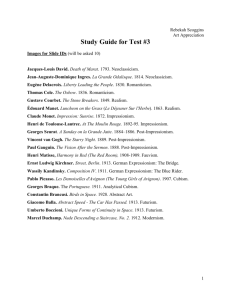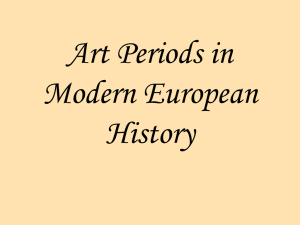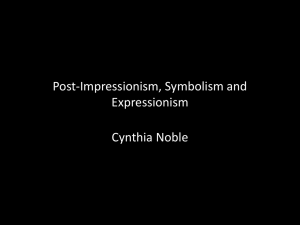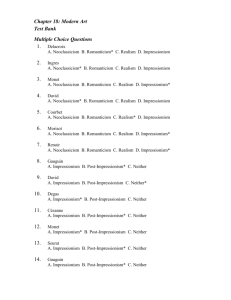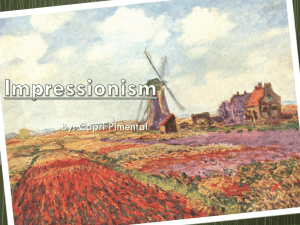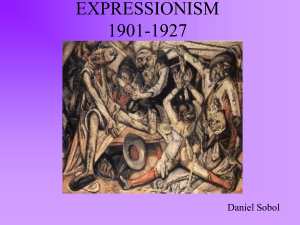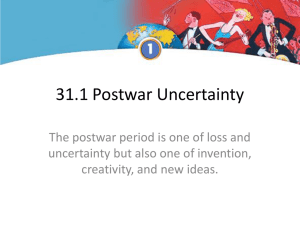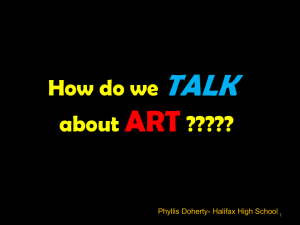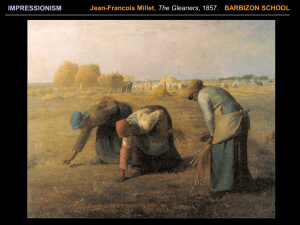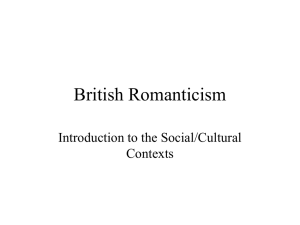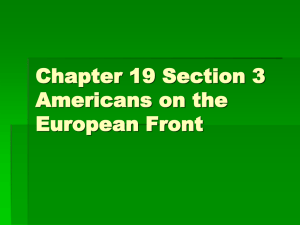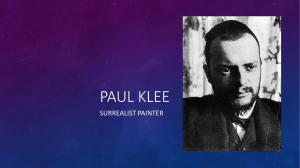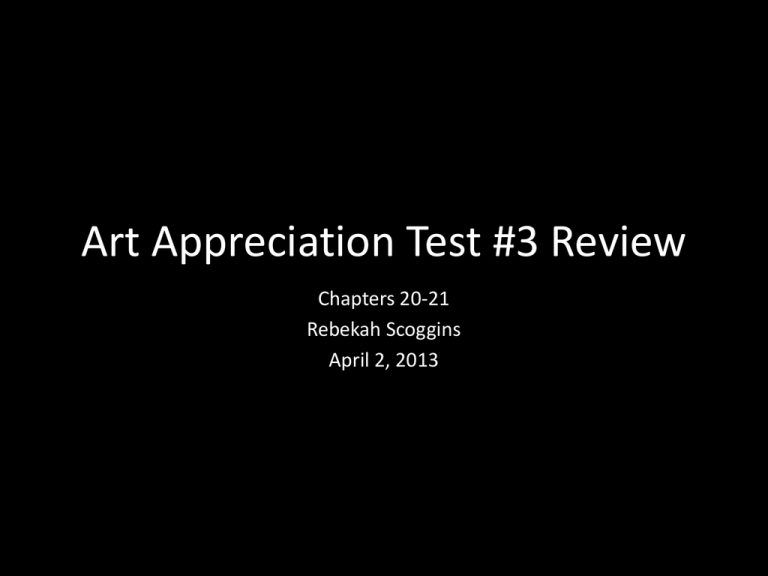
Art Appreciation Test #3 Review
Chapters 20-21
Rebekah Scoggins
April 2, 2013
Wassily Kandinsky. Composition IV. 1911. German Expressionism: The Blue Rider
Giacomo Balla. Abstract Speed - The Car Has Passed. 1913.
Georges Seurat. A Sunday on la Grande Jatte. 1884–1886. Post-Impressionism.
Gustave Courbet. The Stone Breakers. 1849 (destroyed in 1945). Realism.
Henri de Toulouse-Lautrec. At The Moulin Rouge. 1892-95. Impressionism.
Umberto Boccioni. Unique Forms of Continuity in Space. 1913. Futurism.
Eugène Delacroix. Liberty Leading the People. 1830. Romanticism.
Vincent van Gogh. The Starry Night. 1889. Post-Impressionism.
Jean-Auguste-Dominique Ingres. La Grande Odalisque. 1814. Neoclassicism.
Thomas Cole. The Oxbow. 1836. Romanticism.
Copyright ©2011, ©2009 Pearson Prentice Hall Inc.
Jacques-Louis David. Death of
Marat. 1793. Neoclassicism.
Constantin Brancusi. Birds in Space. 1928. Abstract Art.
Pablo Picasso. Les Demoiselles d'Avignon (The Young Girls of Avignon).
1907. Cubism.
Claude Monet. Impression: Sunrise. 1872. Impressionism.
Paul Gauguin. The Vision After the Sermon. 1888. Post-Impressionism.
Ernst Ludwig Kirchner.
Street, Berlin. 1913.
German Expressionism: The Bridge.
Georges Braque. The Portuguese.
1911. Analytical Cubism.
Marcel Duchamp. Nude Descending a
Staircase, No. 2. 1912. Modernism.
Édouard Manet. Luncheon on the Grass (Le Déjeuner Sur l'Herbe). 1863. Realism.
Henri Matisse, Harmony in Red (The Red Room), 1908-1909. Fauvism.
• Industrial Revolution
• French Revolution
• Neoclassicism
Neoclassicism
Jacques-Louis David. Death of
Marat. 1793. Neoclassicism.
Characteristics of Neoclassicism
• The emulation of classical Greek and Roman art
• Much of the subject matter in Neoclassical art
was Roman or Roman inspired.
• Focuses on reason as most important aspect,
Enlightenment values
• Ordered; Calm
• Harmonious; Balanced
• Instructive, containing morals
• Socially conscious
• Romanticism
• Painterly
Francisco Goya. The Third of May, 1808. 1814. Romanticism.
Characteristics of Romanticism
• Believed the path to individual freedom was through
imagination, not reason.
• Had a desire for freedom, not only political, but also of
thought, feeling, action, worship, speech, and taste.
• Believe that imagination and emotion are more valuable
than reason
• Celebrated nature, rural life, common people, and exotic
subjects in art
• Sought to escape fixation on classical form.
• Had painterly brushstrokes; you can see them in the
composition, unlike in the Neoclassical era, which
had invisible brushstrokes.
• Realism
Gustave Courbet. The Stone Breakers. 1849 (destroyed in 1945). Realism.
Realism
A style of art that depicts ordinary existence
without idealism, exoticism, or nostalgia
Dissatisfied with the Neoclassicists & Romantics
Believed that art should deal with human
experience and observation.
Saw dignity of ordinary things and common life.
Often highlighted the underrepresented, the
lower classes; or scenes people were sometimes
uncomfortable viewing.
• Impressionism
Claude Monet. Impression: Sunrise. 1872. Impressionism.
Impressionism
• Opposed academic doctrines and Romantic ideals and
instead turned to portrayals of contemporary society.
• Focused on two main themes: nature and contemporary
city life.
• Considered the art of industrialized, urban Paris.
• Were interested in singular moments, impressions of those
small amounts of time.
• Affirmed modern life
• Saw the beauty of the world as a gift and the forces of
nature as aids to human progress.
• Post Impressionism
• Pointillism
• Japonaiserie
• Post Impressionism
Vincent van Gogh. The Starry Night. 1889. Post-Impressionism.
Post-Impressionism
• Felt the Impressionists were neglecting too many of their
traditional elements of picture making in their attempts to
capture momentary sensations of light and color
• Did not share a singular style
• Much more interested in examining the properties and
expressive qualities of line, pattern, form, and color.
• Some felt that Impressionism’s focus on sketchy immediacy
had sacrificed solidity of form and composition.
• Others felt that Impressionism’s emphasis on the objective
observation did not leave enough room for personal
expression or spiritual content.
• Pointillism
Georges Seurat. A Sunday on la Grande Jatte. 1884–1886. Post-Impressionism.
• Japonaiserie
Vincent van Gogh. Japonaiserie:
Flowering Plum Tree. 1887 After
Hiroshige. Post-Impressionism.
• Avant-garde
• Fauvism
Henri Matisse, Harmony in Red (The Red Room), 1908-1909. Fauvism.
Fauvism
Characterized by areas of bright, contrasting
color and simplified shape and composition
Stunned critic called them “Les fauves,”
which is French for “The Wild Beasts”
Went even further with color than van Gogh
and Gauguin had before, using it both for
expressive and structural ends
• German Expressionism
The Bridge
The Blue Rider
“Inner Necessity”
Ernst Ludwig Kirchner.
Street, Berlin. 1913.
German Expressionism: The Bridge.
The Bridge appealed to artists to
revolt against academic painting
and establish a bridge between
the Germanic past and modern
experience.
Wassily Kandinsky. Blue Mountain. 1908–1909. German Expressionism: The Blue Rider
The Blue Rider wanted to
develop an art that would turn
people away from false
values toward spiritual
rejuvenation.
Kandinsky hoped to create
art only in response to what
he called “inner necessity”
or the emotional stirrings of
the soul, rather than in
response to what he saw in
the world.
German Expressionism
• Shared the expressive goals of the Fauves.
• Desire to display emotions very pronounced
• Developed imagery characterized by vivid,
often angular simplification of their subjects,
dramatic colors contrasts, with bold, at times
crude finish.
• Used the power of Expressionism to address
the human condition, often exploring such
themes as natural life, sorrow, passion,
spirituality, and mysticism.
• Cubism
Analytical Cubism
Synthetic Cubism
Papier Collé/Collage
Georges Braque. The Portuguese.
1911. Analytical Cubism.
Analytical Cubism involved talking
apart, or breaking down, the subject
into its various aspects.
Pablo Picasso. Violin, Fruit,
and Wineglass. 1913.
Synthetic Cubism.
Synthetic Cubism was a process of
building up or combining bits and
pieces of material.
Papier Collé/Collage
• “Prairie Houses”/Open Plan
Frank Lloyd Wright. Robie House. Interior. Chicago, Illinois. 1909. American Modernism.
• Futurism
• Manifesto
Umberto Boccioni. Unique
Forms of Continuity in Space.
1913. Futurism.
• Academic art
• Salon
• Armory Show
Factors that led to Neoclassicism
o Industrial Revolution, began 1760
o American Revolution of 1776
o French Revolution of 1789
o Enlightenment – also known as the Age of Reason, was
the name that characterized the later 18th century,
characterized by:
o The idea that people should be ruled by reason
o Shift to more rational and scientific approach to
religious, political, social, and economic issues
o Belief in the importance of liberty & self determination
Artistic Influences on:
•
•
•
•
•
•
•
•
•
•
Neoclassicism
Impressionism
Post Impressionism
Fauvism
German Expressionism: The Bridge
German Expressionism: The Blue Rider
Cubism
Abstract Sculpture
American Modernism
Futurism
How Was Color Manipulated:
•
•
•
•
•
•
Post Impressionism
Fauvism
German Expressionism: The Bridge
German Expressionism: The Blue Rider
Cubism
Futurists
Artistic Innovations & Shift in Subject Matter of:
•
•
•
•
•
•
•
•
•
•
•
•
Neoclassicism
Romanticism
Realism
Impressionism
Post Impressionism
Fauvism
German Expressionism: The Bridge
German Expressionism: The Blue Rider
Cubism
Abstract Sculpture
American Modernism
Futurism
Who was responsible for the complete break with subject matter?
Wassily Kandinsky. Composition IV. 1911. German Expressionism: The Blue Rider
Comparison?

